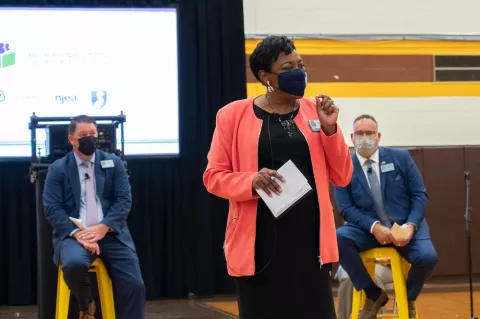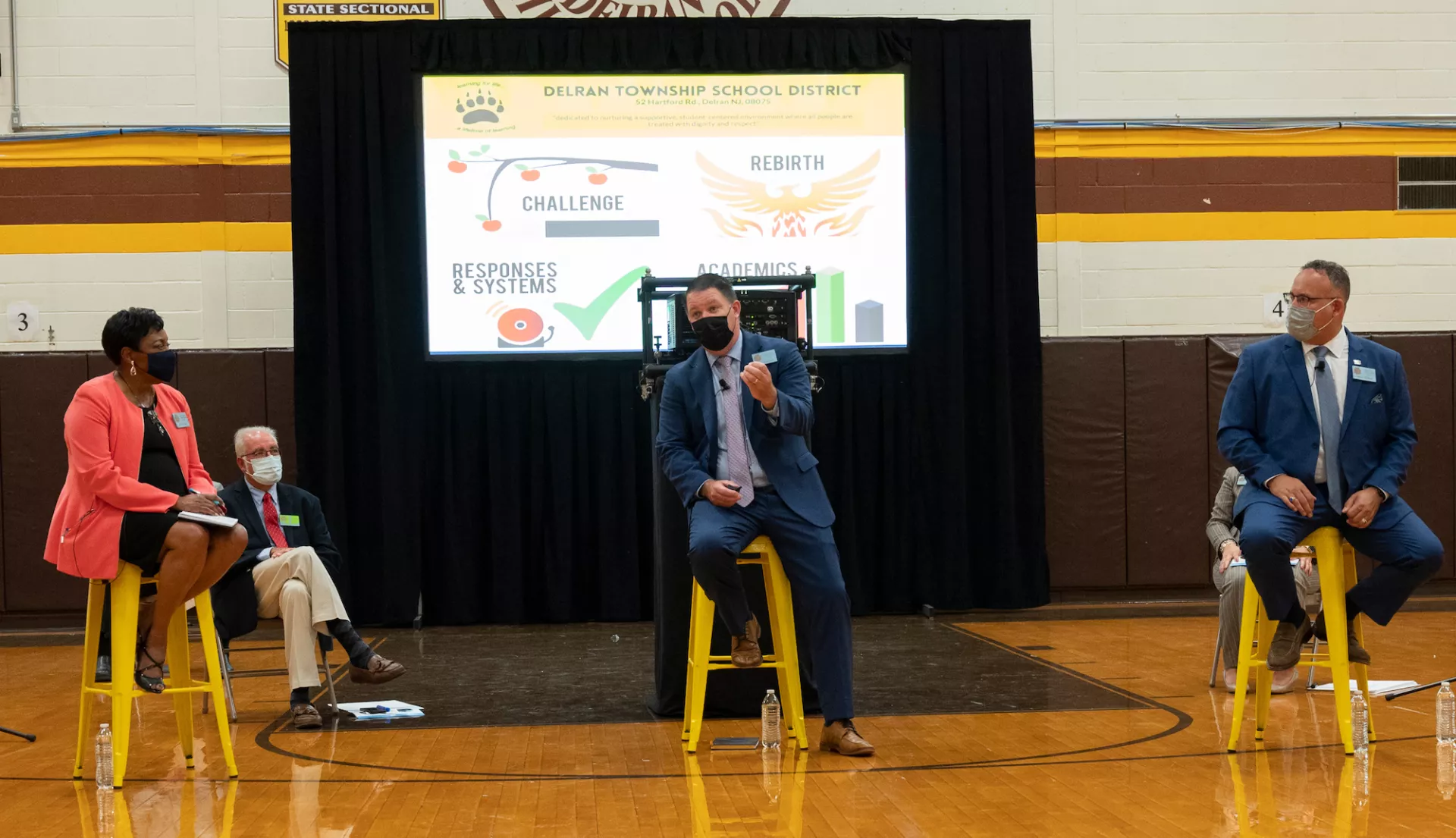Key Takeaways
- Cardona visited Delran High School to learn what makes the New Jersey Public School Labor-Management Collaborative (NJPSLMC) so successful.
- NEA President Becky Pringle emphasized the value of labor-management collaboratives for student achievement and for building a culture of equity in schools for children and adults.
- Cardona concluded that it is the responsibility of the U.S. Department of Education to share nationally collaboration like that in Delran.
U.S. Secretary of Education Miguel Cardona and NEA President Becky Pringle visited Delran High School in Burlington County, New Jersey, for a closer look at a labor-management collaboration that they hope will take root nationwide.
Pringle invited Cardona to the district to learn what makes the New Jersey Public School Labor-Management Collaborative (NJPSLMC) so successful.
On Sept. 8, Pringle and Cardona participated in a socially distanced panel, led by Delran Superintendent Brian Brotschul and Delran Education Association (DEA) Secretary Kathleen McHugh. DEA leaders and Delran Public Schools administrators and board members spoke alongside stakeholder groups, including the New Jersey Education Association (NJEA), the New Jersey School Boards Association, the New Jersey Principals and Supervisors Association, and the New Jersey Association of School Administrators.
Saul Rubinstein, a professor in the Rutgers School of Management and Labor Relations who coordinates the state’s collaborative, also joined the panel.
Pringle emphasized the value of labor-management collaboratives for student achievement and for building a culture of equity in schools for children and adults.
“When adults in the system work together, we can be worthy of our children,” she said.
Praising Delran’s efforts, Cardona said this was the first time he had seen labor-management collaboration connected to student achievement, teacher retention, teacher satisfaction, and teacher and principal efficacy.
“The work that you are doing to collaborate, to engage with partners to pursue success is being noticed,” he said. “And we want to replicate it because we know that that’s what works.”
A Collaborative Culture
The NJPSLMC includes a facilitation team made up of about 15 members who use the experiences in their districts, with support from faculty at Rutgers and NJEA, to encourage and facilitate greater collaboration among unions and management at the state and district levels.
“When we get together, one of the questions that we always ask is who should be at the table, what lenses are missing,” McHugh said. “Because there is value in every viewpoint—whether a custodian, a secretary, a paraprofessional, a teacher.”
These collaborative processes gave the Delran association and district a head start in its response to the COVID-19 pandemic.
"When collaboration is low, teacher retention is 3.5 times lower in high-poverty schools than in low-poverty schools. But when collaboration is high, there is no statistical difference in teacher retention in high-poverty versus low-poverty schools."
“The structures were already there, the trust and relationships were already there, the transparency was already there, and that whole philosophy of being committed to each other’s success was there,” McHugh said.
This enabled the association and district to communicate effectively, troubleshoot concerns, and have a unified message. She hopes that as schools move into another year affected by COVID-19, the collaborative teams can move beyond the operations and logistics required to respond to the pandemic and focus more on academics.
“We have a real commitment to in-person instruction and our membership knows that their voice is being represented and heard,” McHugh said.
Is it Good for Students?
The collaborative’s efforts are grounded in solid data, according to Rubinstein, who has conducted research on the topic with John McCarthy of Cornell University. Rubinstein highlighted a 2017 study of 450 schools and 5,000 educators across six states. The data showed that in schools with high levels of collaboration, an additional 12.5 percent of students tested at or above standards in language arts, and 4.5 percent of students performed at or above standards in math.
The study also found that when collaboration is low, teacher retention is 3.5 times lower in high-poverty schools than in low-poverty schools. But when collaboration is high, there is no statistical difference in teacher retention in high-poverty versus low-poverty schools.
Earlier studies conducted by Rubinstein and McCarthy have found that formal labor-management partnerships lead to improved student performance, more extensive communication between educators, more frequent informal communication between union representatives and school principals, and enhance learning and shared innovation among schools.
Statewide Support for District Collaboration
NJEA Executive Director Steve Swetsky said that for many years advocacy for the things we all care about in education has often been adversarial.
“Here in New Jersey, the things that we’re doing as part of this work around labor management collaboration are about learning, re-learning, unlearning the things that many of us have been taught through years of experience,” he said. “We’re learning that there are other ways to do this work.”
NJEA President Sean M. Spiller added that, “When we invest in this work, we know we are engaging in work that will continue after we are gone or when there are changes in the district. …. The work continues because we know the value of it. It’s built on respect. It’s built on relationships. It’s built on work that is constantly ongoing to make sure that this is successful for our students.”

Systems, not Superheroes
Cardona echoed these sentiments. Asked to come up with headlines summarizing labor-management collaboration, Cardona offered two: “Systems, not superheroes” and “Focus on the process, and the product will follow.”
“Good processes, built on trust, collaboration, and respect, lead to positive outcomes for students, teacher efficacy, a sense of belonging and a sense of shared purpose,” he said.
“When you systematize what works and you are intentional about investing resources of time and money the outcomes improve,” Cardona added. “The resources of the American Rescue Plan are only going to go as far as the culture in which they are embedded. If you have the same amount of money in two different districts with similar demographics, if you have a culture of continuous growth and collaboration with clear systems, you’re going to get more bang for your buck there than if you have it in a system where it’s disjointed. Intentional collaboration works, and intentional collaboration is needed in order to reach the potential that our schools have.”
Cardona concluded that it is the responsibility of districts such as Delran to memorialize the work they are doing around labor management collaboration, and it is the responsibility of the U.S. Department of Education to share it.
“You have something here that you can’t see when you walk in, but it’s critical to the success of the students in this district,” Cardona said. “Nurture that, share it and we’ll do our job to elevate it.”
Scaling Up Success
NEA has provided NJEA with a $500,000 grant to help expand the NJPSLMC in New Jersey and is offering additional funds to help other interested state and local associations across the nation plan and launch partnerships that foster labor-management collaboration practices in districts and worksites.
NEA has also committed to investing more than $3 million over three years to fund and grow the initiative. The partnership will provide resources, mentorships, and a framework to build and enhance quality labor-management collaboration initiatives across the country.
Pringle commended the New Jersey educators, saying, “You are not just making a difference in the lives of the students here. You are making a difference in the lives of students whom you will never meet.”


